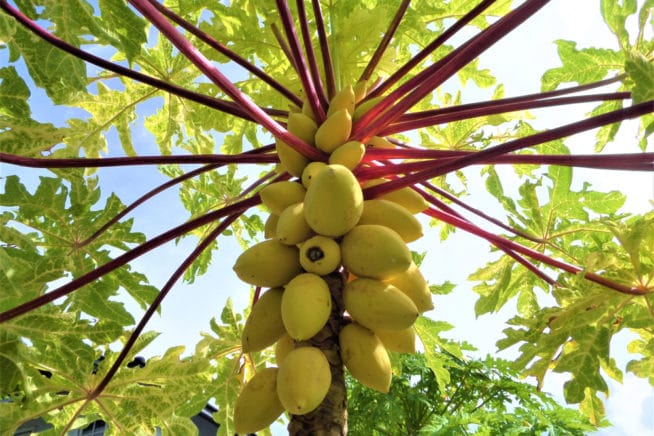
Imagine biting into a juicy, sun-ripened papaya, bursting with tropical flavor. Growing your own papayas is easier than you might think, and it all starts with choosing the perfect spot. This is crucial for a healthy and productive tree, so let's explore the best location to plant your papaya tree!
Finding the Ideal Planting Location for Your Papaya Tree
The secret to successfully growing papayas lies in recreating their natural tropical and subtropical habitat. Papayas thrive in warm, sunny locations with well-drained soil. Neglecting these factors can lead to stunted growth, poor fruit production, and increased susceptibility to diseases. Let's delve into the essential considerations for picking the best location to plant your papaya tree.
Sunlight: The Papaya's Best Friend
Papayas are sun-worshippers! They need a minimum of6-8 hours of direct sunlight daily to flourish. Insufficient sunlight can result in weak stems, pale leaves, and reduced flowering and fruiting. When selecting a planting location, observe how the sun moves throughout the day. Avoid areas shaded by buildings, large trees, or other structures that could block sunlight for extended periods. Consider the seasonal changes in sunlight angle as well. What might be sunny in summer could be shaded in winter. For example, a south-facing location in the northern hemisphere generally receives the most sunlight.
Consider this observation: In areas with consistently overcast skies, supplemental lighting might be necessary to ensure optimal growth. While this might be an extreme measure, it showcases how vital sunlight is to papaya cultivation. Also, remember that younger trees are more vulnerable to sunburn. Provide some afternoon shade to newly planted papayas, especially in very hot climates, using shade cloth or temporary screens.
Soil: Ensuring Proper Drainage for Papaya Trees
Papayas are extremely susceptible to root rot, a fungal disease that thrives in waterlogged conditions. Therefore,well-drained soil is absolutely critical. Heavy clay soils that retain water for extended periods are unsuitable. The ideal soil is loose, sandy loam with good drainage and aeration. Before planting, conduct a simple drainage test. Dig a hole about 1 foot deep and fill it with water. If the water doesn't drain within a few hours, the soil drainage is poor.
If you have heavy clay soil, amend it generously with organic matter such as compost, well-rotted manure, or peat moss. This will improve drainage and aeration, as well as provide essential nutrients. Raised beds are an excellent solution for areas with poorly drained soil. By elevating the planting area, you ensure that the roots are not sitting in stagnant water. The optimal soil p H for papayas is between 6.0 and
6.5, slightly acidic. A soil test can help you determine the p H and amend the soil accordingly with lime (to raise p H) or sulfur (to lower p H).
Case Study: Soil Amendments and Papaya Growth
A study conducted by the University of Hawaii investigated the effects of different soil amendments on papaya growth and yield. The researchers found that adding compost and wood chips to the soil significantly improved drainage, increased soil organic matter content, and resulted in healthier trees with higher fruit yields. This highlights the importance of soil preparation in ensuring the success of your papaya tree.
Protection from Wind: Shielding Your Papaya from Damage
Papayas have large, soft leaves and brittle stems, making them vulnerable to wind damage. Strong winds can easily break branches, defoliate the tree, and even topple it over, especially when laden with fruit. Therefore, choosing a planting location that provides some protection from strong winds is essential. Natural windbreaks, such as hedges or fences, can help to buffer the tree from excessive wind exposure. However, ensure that the windbreak doesn't block sunlight. A slightly sheltered location on the leeward side of a building or hill can also be ideal.
If a naturally sheltered location isn't available, consider planting your papaya tree near other trees that offer some wind protection, but are far enough away to not compete for sunlight and nutrients. For young trees, staking can provide additional support and stability against wind. It's also recommended to prune larger trees in very windy areas to reduce the surface area exposed to the wind.
Temperature: Warmth is Key for Papaya Growth
Papayas thrive in warm temperatures and are sensitive to frost. Ideal temperatures for papaya growth range from 70°F to 90°F (21°C to 32°C). Temperatures below 60°F (15°C) can slow growth, and temperatures below freezing can damage or kill the tree. Therefore, selecting a planting location that is protected from frost and cold temperatures is crucial, especially in cooler climates. Avoid low-lying areas where cold air tends to accumulate.
In areas with occasional frosts, consider planting your papaya tree near a wall or building that can radiate heat and provide some protection. Wrapping the trunk with burlap or blankets can also help to insulate the tree during cold snaps. For those in cooler climate areas, container gardening is a great alternative. Potted papayas can be moved indoors during the winter months to protect them from frost. Select a large pot that allows for adequate root growth and ensure that the potting mix is well-draining.
Summary: Factors Influencing the Best Location to Plant Papaya Tree
To summarize, the best location to plant your papaya tree takes into account the following factors:
- Sunlight: Minimum of 6-8 hours of direct sunlight daily.
- Soil: Well-drained, sandy loam soil with a p H of 6.0-6.5.
- Wind Protection: Shielded from strong winds.
- Temperature: Warm temperatures, protected from frost.
By carefully considering these factors and selecting the ideal planting location, you can provide your papaya tree with the best possible environment for growth, health, and abundant fruit production. Happy planting!